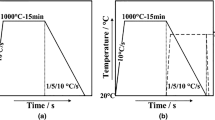Conclusions
-
1.
Thermomechanical treatment can, depending on its type and on the steel's structure, either stabilize or destabilize the residual austenite with respect to martensite transformation during the cooling and subsequent deformation processes. The effects of TMT on the γres →α transformation during cooling and during deformation can be either the same or the opposite.
-
2.
The mechanical properties of two-phase Cr−Mn steels after TMT are determined by the martensite/austenite ratio in the structure, as well as by the development of the γres →α transformation during deformation.
-
3.
By adjusting the structure, the phase strengthening, and the residual austenite stability through a correct selection of TMT type, it is possible to produce high mechanical properties in the Cr−Mn steels studied.
Similar content being viewed by others
Literature cited
I. N. Bogachev and L. I. Lepekhina, "Effect of preliminary plastic deformation on the structure and mechanical properties of Cr−Ni steels," Izv. Akad. Nauk SSSR, Met., No. 3, 157–164 (1974).
L. S. Malinov and A. P. Cheilyakh, Effect of the Residual Austenite Stability on Mechanical Properties of Fe−Cr−Mn Transition Class Steels [in Russian], No. 912, Chermetinformatsiya, Moscow (1980).
K. N. Sokolov, L. S. Malinov, and A. P. Cheilyakh, "New Fe−Cr−Mn steels of the transition class," Izv. Vyssh. Uchebn. Zaved., Chern. Met., No. 7, 107–110 (1981).
M. G. Gaidukov and V. D. Sadovskii, "Effect of plastic deformation on martensite transformation," Metalloved. Term. Obrab. Met. No. 4, 2–7 (1958).
G. V. Kurdyumov et al., "Effect of preliminary plastic deformation on martensite transformation of Fe−Cr−Ni alloys," in: Problems of Metal Science and of Metals Physics [in Russian], No. 5, Metallurgizdat (1958), pp. 41–55.
Yu. G. Virakhovskii, I. Ya. Georgieva, Ya. B. Gurevich, et al., "New class of high-strength, high-plasticity austenitic steels, and the martensite transformation as a stress relaxation mechanism," in: Increasing the Strength of Steels and Alloys [in Russian], F. E. Dzerzhinskii Mosk. Dom Nauch. Tekh. Prop. (1970), pp. 61–62.
L. S. Malinov, and T. D. Éismondt, "Strengthening of unstable Cr−Mn−Ni steels," Izv. Akad. Nauk SSSR, Met., No. 2, 113–120 (1969).
V. B. Spiridonov, L. M. Kuzminskaya, and Yu. P. Gordeev, "Strengthening of Cr−Ni steels containing unstable austenite," Metalloved. Term. Obrab. Met., 2–9 (1973).
Additional information
Zhdanovsk Institute of Metallurgy. Translated from Metallovedenie i Termicheskaya Obrabotka Metallov, No. 2, pp. 36–39, February, 1985.
Rights and permissions
About this article
Cite this article
Malinov, L.S., Cheilyakh, A.P. & Sokolov, K.N. Effect of thermomechanical treatment on the structure and mechanical properties of high-strength Cr−Mn steels of the transition class. Met Sci Heat Treat 27, 130–134 (1985). https://doi.org/10.1007/BF00736586
Issue Date:
DOI: https://doi.org/10.1007/BF00736586




